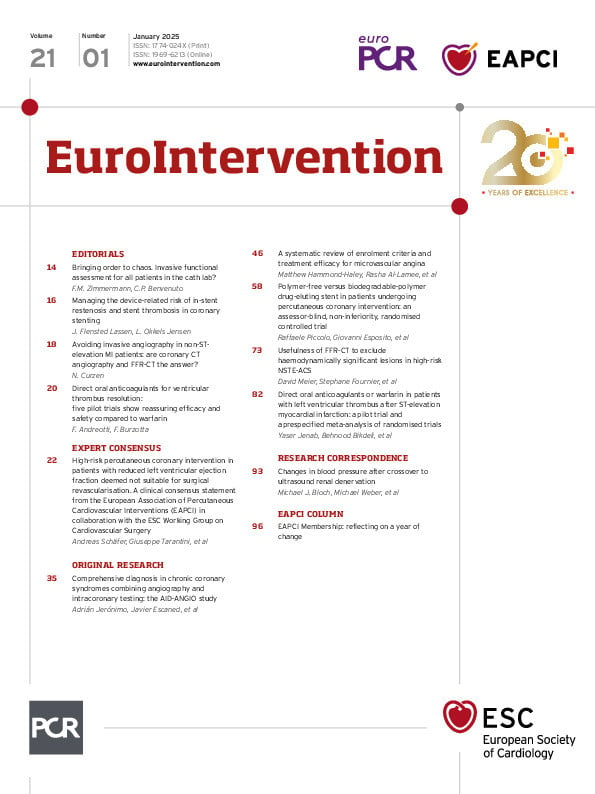Cory:
Unlock Your AI Assistant Now!
Direct oral anticoagulants (DOACs) are easier to use than warfarin1. They are effective and safe in treating venous thromboembolism and in preventing strokes related to most forms of atrial fibrillation (AF)12. DOACs are also recommended for patients with AF and comorbid acute coronary syndromes or undergoing percutaneous coronary intervention (PCI)345. DOACs are contraindicated, however, in patients with thrombotic antiphospholipid syndrome, mechanical heart valves, and rheumatic heart disease, given their lower efficacy and safety compared to warfarin12. For AF associated with end-stage renal disease and – until recently – for left ventricular thrombus (LVT) resolution, the evidence from randomised controlled trials (RCTs) has been insufficient to formulate strong recommendations for or against DOACs2.
LVT after an acute myocardial infarction (MI) can cause devastating embolic strokes36. The incidence of post-infarct LVT has declined thanks to timely pharmacological and mechanical recanalisation that has drastically limited infarct size367. The mechanisms underlying post-infarct LVT formation follow Virchow’s triad and involve ventricular dysfunction and deformation (especially aneurysmatic), flow abnormalities, and prothrombotic/inflammatory reactions in response to infarction and heart failure6789.
The contemporary incidence of LVT complicating acute ST-elevation MI (STEMI) is estimated to be ~5-10%, particularly in the presence of reduced ejection fraction or large anterior infarcts36. In geographical areas and clinical settings lacking prompt MI diagnosis and reperfusion, the incidence will be higher. If not anticoagulated, it is estimated that, in patients with LVT, more than 5 patients per 100 patient-years will develop embolic stroke6. Thus in patients with acute MI, timely detection of LVT and stroke-preventing anticoagulant strategies (vitamin K antagonist or DOAC) are recommended (Class IIa), albeit with a level of evidence (LoE) C3.
Four pilot trials have compared apixaban or rivaroxaban against warfarin in the setting of LVT (typically post-acute MI) and reported 90-day LVT resolution rates; the sample size has ranged from 27 to 79 patients per trial, with follow-up durations of 3-12 months10.
In this issue of EuroIntervention, Jenab et al report the results of a fifth trial, REWARF-STEMI10. The authors also perform a prespecified meta-analysis of the available RCT evidence10.
In REWARF-STEMI, 50 patients with post-STEMI LVT, diagnosed by non-contrast transthoracic echocardiography at two medical centres, were randomised to either rivaroxaban 20 (or 15) mg daily or to warfarin targeted to an international normalised ratio of 2.0-2.5; all were revascularised (49 by primary PCI and one by emergent bypass surgery) and all received daily clopidogrel 75 mg and aspirin 80 mg10. The primary endpoint was complete LVT resolution at 3 months; secondary endpoints were relevant bleeding, deaths, and non-fatal ischaemic events10. At 90 days, REWARF-STEMI showed a favourable trend for complete LVT resolution with rivaroxaban compared to warfarin (risk ratio [RR] 1.40, 95% confidence interval [CI]: 0.91-2.15; p=0.12)10. There was one sudden death on day 31 in the rivaroxaban arm, and no major International Society on Thrombosis and Haemostasis (ISTH) bleeding in either arm10.
On meta-analysis, the DOACs that were tested against warfarin in the 5 trials (apixaban 5 mg twice daily in ~110 patients and rivaroxaban 20 mg daily in ~120 patients) maintained a small favourable trend for LVT resolution (RR 1.14, 95% CI: 0.98-1.32; p=0.08) and showed a reduction in ISTH major bleeding: 1.7% versus 8% (p=0.05)10. These preliminary findings suggest that apixaban and rivaroxaban are as safe (and maybe safer than) and as effective as warfarin in resolving post-infarct LVT. The present meta-analysis provides a small but consistent evidence base for the use of rivaroxaban or apixaban instead of warfarin to treat post-infarct LVT, with a cautious LoE B. The clinical implications are the ease of use of rivaroxaban and apixaban compared to warfarin, the prompt onset (and offset) of anticoagulant effects, the predictable pharmacology with limited drug-drug interactions and with no need for routine monitoring13.
The 5 randomised pilot trials share similar designs (mostly open-label with blinded outcome assessment), similar patient populations (mainly post-STEMI), and similar primary outcome definitions (thrombus resolution at 90 days)10. The limitations of these trials include the small number of patients (228 patients in all, followed up for 3-12 months), with uncertain generalisability to larger groups, and underpowered to assess non-fatal ischaemic events or deaths; the diagnosis of LVT using non-contrast transthoracic echocardiography (less sensitive, but easier and cheaper than the “gold standard” magnetic resonance imaging)6; the paucity of major bleeding events (none in 2 of 5 trials); the open-label design with the associated risk of bias; and uncertainties over times in therapeutic range or initial bridging procedures in the warfarin-treated arms.
Gaps in evidence for the management of patients with post-infarct LVT include (i) the efficacy and safety of edoxaban or dabigatran compared to warfarin; (ii) strategies to prevent LVT development in the first place; (iii) the relative value of accurate/sustainable diagnostic tools; (iv) ways to gauge the duration of anticoagulation; and (v) the impact of different anticoagulant and antiplatelet combinations on ischaemic and fatal events (in addition to thrombus resolution and bleeding). Seven trials in the pipeline (see ClinicalTrials.gov and Supplementary Table 3 from Jenab et al10) should provide new information on the effects of rivaroxaban+dual antiplatelet therapy (DAPT) versus DAPT alone, on rivaroxaban or apixaban versus warfarin (each on top of antiplatelet therapy), and on clopidogrel- or ticagrelor-based DAPT combined with either dabigatran or warfarin.
In conclusion, the paper by Jenab et al reporting the results of a new randomised pilot trial together with a careful systematic review and meta-analysis supports the use of rivaroxaban or apixaban instead of warfarin for post-MI LVT resolution.
Conflict of interest statement
F. Andreotti reports receiving, in the past 36 months, consultant or speaker fees from Amgen, AstraZeneca, Bayer, BMS/Pfizer, Daiichi Sankyo, Menarini, Novo Nordisk, and Servier, outside the present work. F. Burzotta reports receiving, in the past 36 months, speaker fees from Abbott, Abiomed, Daiichi Sankyo, Medtronic, and Terumo, outside the present work.

